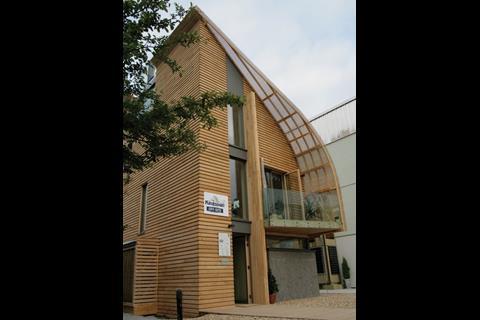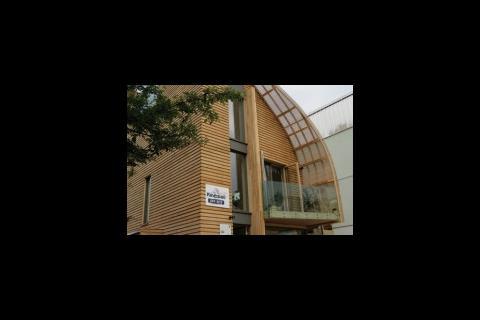The government has committed itself to making new homes zero carbon after 2016. But a lot depends on how you define zero … Isabel McAllister of Cyril Sweett reports
01 / redefining zero-carbon homes
You might think that it would be relatively straightforward to define a zero-carbon home, but the construction industry has spent the past 18 months tying itself in knots over the issue. The government’s recent consultation provides an insight into where the debate is going; this article provides an overview of some of the key issues.
• The current position The government is committed to reducing UK CO2 emissions 80% by 2050. With housing representing about a quarter of those emissions and with 35% of our 2050 housing likely to be built after 2008, it is understandable that much policy emphasis has been placed on low and zero-carbon buildings.
It was back in December 2006, that the government made the first proposals that all new homes would be “zero carbon” after 2016. At the time, zero-carbon status required that over the course of a year, a development would emit no CO2 from its heating, hot water, lighting and appliances. All of the carbon reductions had to be achieved using local “off-site” technologies connected to the development by a direct physical connection (e.g. a private wire arrangement).
Analysis was undertaken to determine the costs of delivering this policy (examples are shown in tables one and two). As might be expected, costs and benefits vary depending on the scale and location of development and the mix of housetypes. Table one presents the costs of achieving a zero-carbon home entirely through on-site solutions, but without any mandatory levels of energy efficiency; table two presents the costs if high levels of thermal performance are required (that is, the “advanced practice standard” advocated by the Energy Savings Trust).
These (tables one and two), and other analyses, highlighted concerns regarding the deliverability of zero carbon using exclusively on-site solutions. These include:
- The impact on capital cost and project viability
- The technical feasibility of delivery
- The over-reliance on specific technologies, notably biomass and biomass combined heat and power.
In addition, recent proposals to revise the SAP assessment method by which domestic CO2 emissions are modelled (specifically, revisions of the emission factor for electrical generation on site) would reduce the amount of carbon reduction achieved through on-site generation by about 25%, further exacerbating concerns over deliverability and cost.
Consequently, the government recently consulted on alternative definitions of a zero-carbon home. These comprise minimum standards of energy efficiency, a defined level of carbon savings to be achieved on site and the reduction of residual emissions through a range of potential “allowable solutions” (see fig 1).

02 / What do these measures mean?
Measure
Energy efficiency
Carbon compliance
(the minimum level of reduction in CO2 emissions that must be achieved on site and/or through direct connection of low/zero carbon heat
Allowable solutions
(a range of options for dealing with the residual CO2 emissions not tackled by on-site renewable energy generation and/or direct connection to low/zero-carbon heat)
Achieved how?
Improved insulation, low-energy lighting, high efficiency pumps, fans
Limited application of renewable energy and/or connection to district heating to achieve a minimum level of reduction in CO2 emissions
Any or all of the following …
- On-site renewable energy generation
- Installation of energy efficient appliances/building control systems
- Exports of low-carbon or renewable heat (or cooling) to surrounding developments
- S106 planning obligations towards allowable solutions
- Retrofitting of existing buildings in the locality
- Investments in LZC energy infrastructure (benefits of ownership transferred to homebuyer)
- Offsite renewable electricity connected via direct physical connection
- Any other measures announced by government
03 / the issues involved
• What is the policy trying to achieve? It is worth remembering that the primary objective of the zero-carbon homes policy is to avoid the increase in emissions that would otherwise arise from developing three million homes by 2020. In addition, the expectation is that the policy will deliver related benefits by improving housing quality and stimulate the uptake in green technologies.
Therefore, while alternative definitions of zero carbon have generated much discussion in the industry, and could be interpreted as a relaxation in the earlier commitment to zero carbon, they should also be considered in the context of the primary policy objectives of reducing UK carbon emissions rather than as a tool for environmental grandstanding or point-scoring with other nations.
The remainder of this article considers some of the key discussion points and summarises best and worst-case cost scenarios.
• Will the new definitions secure more or less carbon savings than the current definition? One area of concern with the current definition of zero carbon is whether or not the on-site micro low or zero-carbon technologies will be effectively maintained and replaced at the end of their lives. Many of the micro technologies are expected to last about 15-25 years and will require the replacement of at least one key component over this period.
Consequently, the forms of carbon saving prioritised under the new definition (for example, thermal performance and larger scale offsite initiatives) are likely to provide greater longevity and reliability. This is because improved thermal performance is essentially a passive solution, whereas larger scale initiatives will be managed professionally with higher levels of availability and adequate provision for maintenance and replacement as needed.
As a result, the total carbon savings from different definitions of zero carbon are predicted to be higher if a higher proportion of the carbon saving is delivered offsite (see table three).
This analysis is, of course, reliant on the assumption that larger, centrally managed solutions will be operational longer than micro solutions managed by individual householders, but it does show that reducing the proportion of emission reduction required on site should not have a negative impact on overall carbon savings.
• Are the options being considered easier to deliver? If SAP is revised to include the same carbon emission factors for all grid electricity, most homes would not be able to achieve zero-carbon status through on-site solutions alone. Many homes could not take advantage of technologies such as biomass CHP that need scale to be effective, and would not have the space to accommodate photovoltaic panels.
Another primary concern is a reliance on a few technology types, such as biomass (both heating and CHP). There would be a rapid, massive increase in demand for them, and although biomass is considered a zero/low-carbon fuel supply, it also presents a number of challenges and concerns. In particular, how the biomass is grown and transported, whether a fuel supply can be guaranteed, and whether the technologies in smaller scale schemes are reliable.
Alternative zero-carbon definitions requiring 44% or 70% of regulated carbon savings to be achieved on site could be met using a variety of technologies for all types of housing.
The alternative definitions of zero carbon that allow some carbon saving offsite should therefore be more technically feasible and provide a greater range of options.
• How might the quality of new homes be affected? The greater flexibility afforded by the definitions being considered should allow developers and design teams to focus on design quality, rather than accommodating on-site energy generation. In addition, the proposals to achieve minimum energy efficiency standards will ensure energy consumption in new homes is as low as practicable. In contrast, a fully on site definition of zero carbon that does not have high mandatory energy-efficiency standards might deliver far less saving.
It is true that delivering carbon reductions through “allowable” solutions will, in most cases, not result in any further cost savings to the homeowner. However, these solutions should have the more significant effect of reducing energy costs for vulnerable groups, for example by helping to fund the decarbonisation of the National Grid .
• How will we know that a home has actually achieved zero carbon status? Verification and enforcement of the Building Regulations is an ongoing challenge and the additional complexities brought by any move to zero carbon are unlikely to help matters. Arguably, the demands on building control officers should be less for a zero-carbon definition that incorporates allowable solutions, as the on-site standards should require less complex analysis.
Nonetheless, this still leaves the question of administering and verifying allowable solutions. The detailed mechanisms for verifying allowable solutions (including methods of measuring emissions) have not yet been developed.
However, the revised definitions should present opportunities for companies or community groups to develop products or services that facilitate the delivery of cost-effective carbon savings. In this case, the government’s role would be to set the mechanism for ensuring effective quantification, quality, additionality and the continuing performance of these measures.
It is expected that the approach underlying the revised zero-carbon definition will be applied to domestic and non-domestic properties. This means that a single set of systems for allowable solutions could be developed for all forms of development, thereby providing opportunities for efficiencies and economies of scale.
• How can we be sure that the revised policy commitments won’t cannibalise savings that might be achieved by other policies? There is a potential overlap between allowable solutions and policy initiatives such as the heat and energy saving strategy, the renewables obligations and the European emissions trading scheme.
Two of the available allowable solutions that are of particular interest are large-scale off-site renewables such as wind turbines and the improvement of the existing building stock. Although these options present more economic ways of reducing carbon emissions, full consideration must be given to the impact of using them to deliver the 80% emissions reduction.
It could be argued that without the money provided by new housebuilding it would be difficult to finance the refurbishment of existing homes without increases in utility bills or taxation. Alternatively, building zero-carbon homes may not be sufficient to achieve the reduction required by 2050. If this is the case, we would be forced to pursue more expensive solutions at a later date.
It is also important to recognise the historic difficulties of delivering large scale low and zero-carbon schemes in the UK. Although polices are becoming more supportive of renewable energy, the challenges presented by, for example, the planning process, should not be forgotten.
Further work will be required to ensure that resources are not allocated inappropriately.
• What might be the impact on development cost? The definitions being considered are likely to be significantly less costly to implement and should also require less complex long-term management. The costs of carbon compliance and allowable solutions under different definitions for an average home are summarised in table four (see below).
Table four indicates that, depending on the final definition, there are opportunities for substantial cost savings for a typical home.
Delivering zero carbon purely using on-site means is estimated to cost upwards of £40,000 for a single detached home, whereas with a definition that requires advanced energy efficiency and a 70% on-site reduction in carbon emissions, the construction cost premium would be about £16,000, plus a further £800 to £3,500 for installing the allowable solutions.
• Therefore … The alternative definitions of zero carbon being considered at the moment are not as sexy or absolute as making all the carbon savings on site. However, analysis suggests that they present a more pragmatic and cost-effective approach to contributing to the UK’s climate change targets while also providing higher quality and more energy efficient housing.
The greater emphasis on offsite allowable solutions, which would typically be more actively managed than on-site remedies, and be more likely to be maintained in the long term may result in these alternative definitions providing greater and more reliable carbon savings than an exclusively on-site approach.
However, all this is contingent on the sufficient quantity of allowable solutions being delivered (this might be up to 100 million tonnes of carbon dioxide by 2065) without affecting the capacity of other initiatives to deliver their contribution.





























3 Readers' comments